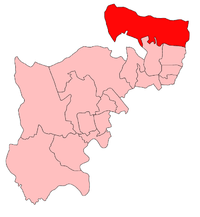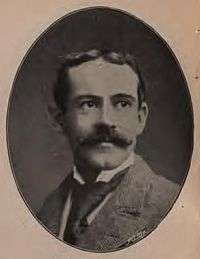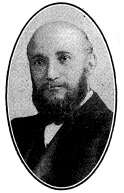Enfield (UK Parliament constituency)
Enfield was a constituency for the House of Commons of the UK Parliament from 1885 until 1950. The area sloping to the River Lea in the east was in the far north of Middlesex centred on the town of Enfield. The area formed part of the London conurbation and was much reduced over the course of its existence, in 1918 and then insignificantly in 1945 due to suburbanisation and urbanisation. It returned one Member of Parliament (MP).
| Enfield | |
|---|---|
| Former constituency for the House of Commons | |
 Enfield 1885-1918 | |
 Enfield 1918-45 | |
| 1885–1950 | |
| Number of members | one |
| Replaced by | Edmonton (south east of seat in 1918) Finchley (as to Friern Barnet in 1918) Wood Green (as to Southgate, south part of Enfield) Enfield East and Enfield West (in 1950) |
| Created from | Middlesex |
History
The constituency was created by the Redistribution of Seats Act 1885 for the 1885 general election, and abolished for the 1950 general election. It was then replaced by the new Enfield East and Enfield West constituencies.
Boundaries
1885–1918: The parishes of Edmonton, Enfield, Friern Barnet, Monken Hadley, and South Mimms. These reflected ancient parishes and the smallest in the non-metropolitan county, Monken Hadley was a small rectangle in the south-centre of the seat. Friern Barnet formed a projection in the south-west running north-west reflecting the eccentric shape of this part of the county border. The latter adjoined Barnet in Hertfordshire as much of the rest did and joined the parishes of Hornsey and Finchley to the south.
1918–1950: The Urban District of Enfield, and the Rural District of South Mimms. The Representation of the People Act 1918 redrew constituencies throughout Great Britain, and defined them in terms of the new urban and rural districts introduced by the Local Government Act 1894. Of the areas transferred to other constituencies in this redistribution, Edmonton became a separate constituency, while Friern Barnet was transferred to the new Finchley seat. A "Wood Green" seat was devised which took the Southgate southern parts of Enfield and western extreme of Edmonton parish.[1]
^ Note a: Renamed as Potters Bar Urban District in 1934.
Members of Parliament
| Election | Member | Party | |
|---|---|---|---|
| 1885 | William Pleydell-Bouverie | Conservative | |
| 1889 by-election | Henry Bowles | Conservative | |
| 1906 | James Branch | Liberal | |
| 1910 | John Pretyman Newman | Conservative | |
| 1918 | Henry Bowles | Conservative | |
| 1922 | Thomas Fermor-Hesketh | Conservative | |
| 1923 | William Henderson | Labour | |
| 1924 | Reginald Applin | Conservative | |
| 1929 | William Henderson | Labour | |
| 1931 | Reginald Applin | Conservative | |
| 1935 | Bartle Bull | Conservative | |
| 1945 | Ernest Davies | Labour | |
| 1950 | constituency abolished: see Enfield East and Enfield West | ||
Elections
Elections in the 1880s
| Party | Candidate | Votes | % | ± | |
|---|---|---|---|---|---|
| Conservative | William Pleydell-Bouverie | 3,644 | 57.6 | N/A | |
| Liberal | John Kempster | 2,684 | 42.4 | N/A | |
| Majority | 960 | 15.2 | N/A | ||
| Turnout | 6,328 | 73.4 | N/A | ||
| Registered electors | 8,621 | ||||
| Conservative win (new seat) | |||||
| Party | Candidate | Votes | % | ± | |
|---|---|---|---|---|---|
| Conservative | William Pleydell-Bouverie | 3,287 | 75.5 | +17.9 | |
| Liberal | John Treeve Edgcombe[4] | 1,067 | 24.5 | -17.9 | |
| Majority | 2,220 | 51.0 | +35.8 | ||
| Turnout | 4,354 | 50.5 | −22.9 | ||
| Registered electors | 8,621 | ||||
| Conservative hold | Swing | +17.9 | |||
Pleydell-Bouverie was appointed Treasurer of the Household, requiring a by-election.
| Party | Candidate | Votes | % | ± | |
|---|---|---|---|---|---|
| Conservative | William Pleydell-Bouverie | Unopposed | |||
| Conservative hold | |||||
Pleydell-Bouverie was elevated to the peerage, becoming Earl of Radnor, causing a by-election.

| Party | Candidate | Votes | % | ± | |
|---|---|---|---|---|---|
| Conservative | Henry Bowles | 5,124 | 58.7 | −16.8 | |
| Liberal | William Henry Fairbairns[7] | 3,612 | 41.3 | +16.8 | |
| Majority | 1,512 | 17.4 | −33.6 | ||
| Turnout | 6,636 | 79.5 | +29.0 | ||
| Registered electors | 10,993 | ||||
| Conservative hold | Swing | −16.8 | |||
Elections in the 1890s
| Party | Candidate | Votes | % | ± | |
|---|---|---|---|---|---|
| Conservative | Henry Bowles | 5,491 | 60.0 | −15.5 | |
| Liberal | Albert Stephen Hatchett-Jones[9] | 3,660 | 40.0 | +15.5 | |
| Majority | 1,831 | 20.0 | −31.0 | ||
| Turnout | 9,151 | 72.2 | +21.7 | ||
| Registered electors | 12,674 | ||||
| Conservative hold | Swing | −15.5 | |||
| Party | Candidate | Votes | % | ± | |
|---|---|---|---|---|---|
| Conservative | Henry Bowles | Unopposed | |||
| Conservative hold | |||||
Elections in the 1900s
| Party | Candidate | Votes | % | ± | |
|---|---|---|---|---|---|
| Conservative | Henry Bowles | 6,923 | 65.5 | N/A | |
| Liberal | Charles Stewart Crole | 3,655 | 34.5 | New | |
| Majority | 3,268 | 31.0 | N/A | ||
| Turnout | 10,578 | 62.1 | N/A | ||
| Registered electors | 17,044 | ||||
| Conservative hold | Swing | N/A | |||

| Party | Candidate | Votes | % | ± | |
|---|---|---|---|---|---|
| Liberal | James Branch | 9,790 | 56.1 | +21.6 | |
| Conservative | Henry Bowles | 7,674 | 43.9 | −21.6 | |
| Majority | 2,116 | 12.2 | N/A | ||
| Turnout | 17,464 | 74.7 | +12.6 | ||
| Registered electors | 23,386 | ||||
| Liberal gain from Conservative | Swing | +21.6 | |||
Elections in the 1910s
| Party | Candidate | Votes | % | ± | |
|---|---|---|---|---|---|
| Conservative | John Pretyman Newman | 12,625 | 52.6 | +8.7 | |
| Liberal | James Branch | 11,383 | 47.4 | −8.7 | |
| Majority | 1,242 | 5.2 | N/A | ||
| Turnout | 24,008 | 84.0 | +9.3 | ||
| Registered electors | 28,571 | ||||
| Conservative gain from Liberal | Swing | +8.7 | |||
| Party | Candidate | Votes | % | ± | |
|---|---|---|---|---|---|
| Conservative | John Pretyman Newman | 11,495 | 52.1 | −0.5 | |
| Liberal | James Branch | 10,559 | 47.9 | +0.5 | |
| Majority | 936 | 4.2 | −1.0 | ||
| Turnout | 22,054 | 77.2 | −6.8 | ||
| Registered electors | 28,571 | ||||
| Conservative hold | Swing | −0.5 | |||
General Election 1914/15:
Another General Election was required to take place before the end of 1915. The political parties had been making preparations for an election to take place and by the July 1914, the following candidates had been selected;
- Unionist: John Pretyman Newman
- Liberal: John McEwan
| Party | Candidate | Votes | % | ± | |
|---|---|---|---|---|---|
| C | Unionist | Henry Bowles | 8,290 | 50.4 | −1.7 |
| Labour | William E. Hill | 6,176 | 37.5 | New | |
| Liberal | Janet McEwan | 1,987 | 12.1 | −35.8 | |
| Majority | 2,114 | 12.9 | +8.7 | ||
| Turnout | 16,453 | 54.8 | −22.4 | ||
| Registered electors | 30,031 | ||||
| Unionist hold | Swing | +17.1 | |||
| C indicates candidate endorsed by the coalition government. | |||||
Elections in the 1920s
| Party | Candidate | Votes | % | ± | |
|---|---|---|---|---|---|
| Unionist | Thomas Fermor-Hesketh | 11,725 | 54.4 | +4.0 | |
| Labour | George Lathan | 9,820 | 45.6 | +8.1 | |
| Majority | 1,905 | 8.8 | −4.1 | ||
| Turnout | 21,545 | 71.8 | +17.0 | ||
| Registered electors | 29,992 | ||||
| Unionist hold | Swing | −2.1 | |||
| Party | Candidate | Votes | % | ± | |
|---|---|---|---|---|---|
| Labour | William Henderson | 11,050 | 52.8 | +7.2 | |
| Unionist | Thomas Fermor-Hesketh | 9,888 | 47.2 | −7.2 | |
| Majority | 1,162 | 5.6 | N/A | ||
| Turnout | 20,938 | 68.5 | −3.3 | ||
| Registered electors | 30,580 | ||||
| Labour gain from Unionist | Swing | +7.2 | |||
| Party | Candidate | Votes | % | ± | |
|---|---|---|---|---|---|
| Unionist | Reginald Applin | 13,886 | 54.0 | +6.8 | |
| Labour | William Henderson | 11,807 | 46.0 | −6.8 | |
| Majority | 2,079 | 8.0 | N/A | ||
| Turnout | 25,693 | 81.8 | +13.3 | ||
| Registered electors | 31,396 | ||||
| Unionist gain from Labour | Swing | +6.8 | |||
| Party | Candidate | Votes | % | ± | |
|---|---|---|---|---|---|
| Labour | William Henderson | 14,427 | 43.3 | −2.7 | |
| Unionist | Reginald Applin | 14,169 | 42.5 | −11.5 | |
| Liberal | Charles Herbert Durrad-Lang | 4,736 | 14.2 | New | |
| Majority | 258 | 0.8 | N/A | ||
| Turnout | 33,332 | 78.5 | −3.3 | ||
| Registered electors | 42,481 | ||||
| Labour gain from Unionist | Swing | +4.4 | |||
Elections in the 1930s
| Party | Candidate | Votes | % | ± | |
|---|---|---|---|---|---|
| Conservative | Reginald Applin | 24,532 | 64.3 | +21.8 | |
| Labour | William Mellor | 13,646 | 35.7 | -7.6 | |
| Majority | 10,886 | 28.6 | N/A | ||
| Turnout | 38,178 | 79.2 | +0.7 | ||
| Conservative gain from Labour | Swing | ||||
| Party | Candidate | Votes | % | ± | |
|---|---|---|---|---|---|
| Conservative | Bartle Bull | 24,046 | 56.5 | -7.8 | |
| Labour | William Mellor | 18,543 | 43.5 | +7.8 | |
| Majority | 5,503 | 13.0 | -15.6 | ||
| Turnout | 42,589 | 73.2 | -6.0 | ||
| Conservative hold | Swing | -7.8 | |||
General Election 1939/40
Another General Election was required to take place before the end of 1940. The political parties had been making preparations for an election to take place and by the Autumn of 1939, the following candidates had been selected;
- Conservative: Bartle Bull
- Labour: Ernest Davies[22]
Elections in the 1940s
| Party | Candidate | Votes | % | ± | |
|---|---|---|---|---|---|
| Labour | Ernest Davies | 32,625 | 52.1 | +8.6 | |
| Conservative | Bartle Bull | 20,935 | 33.4 | -23.1 | |
| Liberal | John Patrick Cyril Danny | 9,104 | 14.5 | New | |
| Majority | 11,690 | 18.7 | N/A | ||
| Turnout | 62,664 | 74.4 | +1.2 | ||
| Labour gain from Conservative | Swing | +15.8 | |||
References
- Youngs, Frederic A, Jr. (1979). Guide to the Local Administrative Units of England, Vol.I: Southern England. London: Royal Historical Society. pp. 748–750. ISBN 0-901050-67-9.
- British parliamentary election results, 1885-1918 (Craig)
- British parliamentary election results, 1885-1918 (Craig)
- "Yesterday's Nominations". London Evening Standard. 2 Jul 1886. p. 3. Retrieved 26 November 2017 – via British Newspaper Archive.
- British parliamentary election results, 1885-1918 (Craig)
- British parliamentary election results, 1885-1918 (Craig)
- "Election Intelligence". Grantham Journal. 30 Mar 1889. p. 6. Retrieved 26 November 2017 – via British Newspaper Archive.
- British parliamentary election results, 1885-1918 (Craig)
- London Middlesex Gazette: 6. 17 December 1910 https://newspaperarchive.com/london-middlesex-gazette-dec-17-1910-p-6/. Missing or empty
|title=(help) - British parliamentary election results, 1885-1918 (Craig)
- British parliamentary election results, 1885-1918 (Craig)
- British parliamentary election results, 1885-1918 (Craig)
- British parliamentary election results, 1885-1918 (Craig)
- British parliamentary election results, 1885-1918 (Craig)
- British Parliamentary Election Results 1918-1949, FWS Craig
- British Parliamentary Election Results 1918-1949, FWS Craig
- British Parliamentary Election Results 1918-1949, FWS Craig
- British Parliamentary Election Results 1918-1949, FWS Craig
- British Parliamentary Election Results 1918-1949, FWS Craig
- British Parliamentary Election Results 1918-1949, FWS Craig
- British Parliamentary Election Results 1918-1949, FWS Craig
- Report of the Annual Conference of the Labour Party, 1939
- British Parliamentary Election Results 1918-1949, FWS Craig